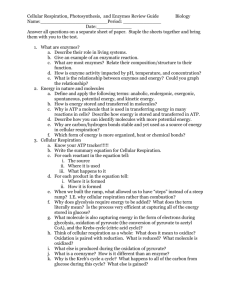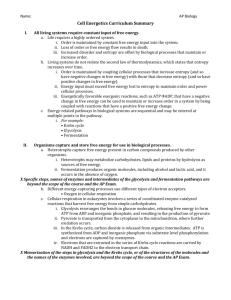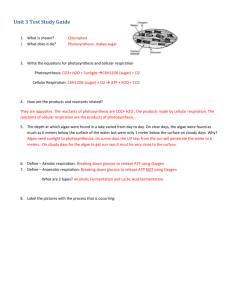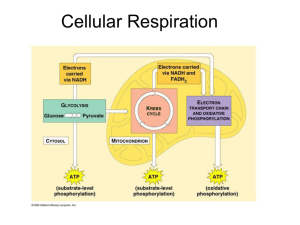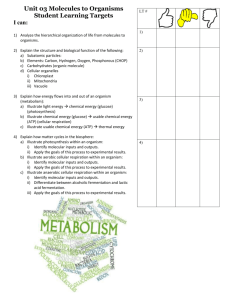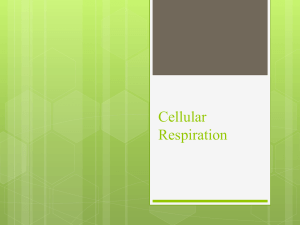The Electron Transport Chain
advertisement
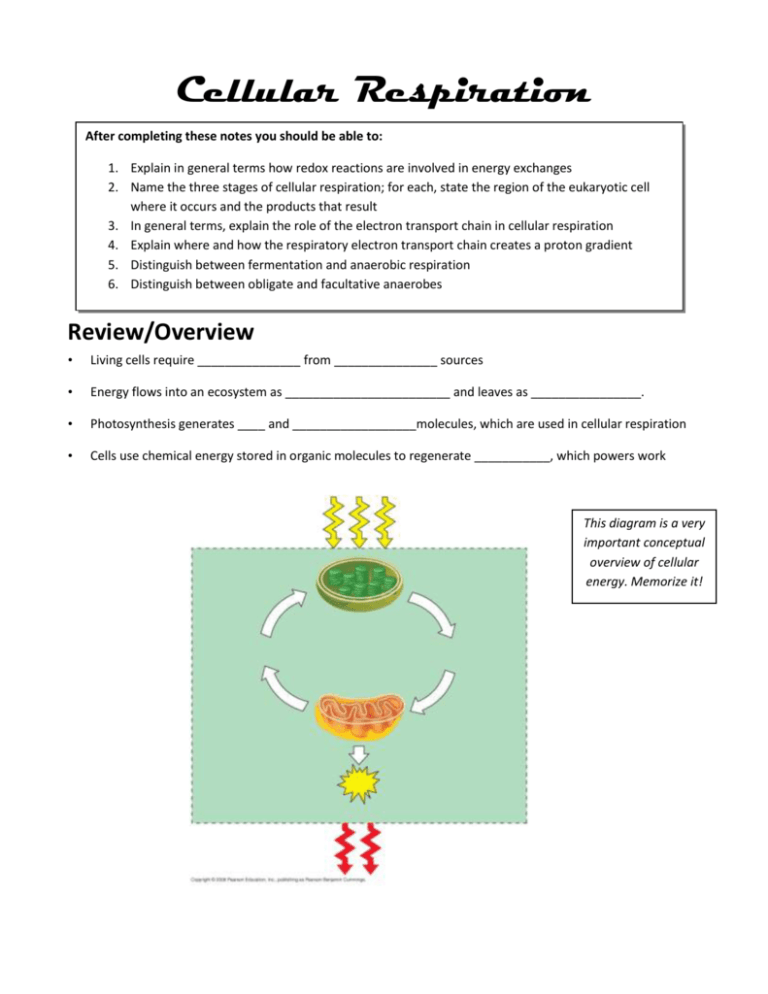
Cellular Respiration After completing these notes you should be able to: 1. Explain in general terms how redox reactions are involved in energy exchanges 2. Name the three stages of cellular respiration; for each, state the region of the eukaryotic cell where it occurs and the products that result 3. In general terms, explain the role of the electron transport chain in cellular respiration 4. Explain where and how the respiratory electron transport chain creates a proton gradient 5. Distinguish between fermentation and anaerobic respiration 6. Distinguish between obligate and facultative anaerobes Review/Overview • Living cells require _______________ from _______________ sources • Energy flows into an ecosystem as ________________________ and leaves as ________________. • Photosynthesis generates ____ and __________________molecules, which are used in cellular respiration • Cells use chemical energy stored in organic molecules to regenerate ___________, which powers work This diagram is a very important conceptual overview of cellular energy. Memorize it! Catabolic Pathways and the production of ATP • The breakdown of organic molecules is ____________________ (releases energy) • ______________________ is a partial degradation of sugars that occurs without O2 • _____________________ respiration consumes organic molecules and O2 and yields ATP • ___________________ respiration is similar to aerobic respiration but consumes compounds other than O2 • ___________________ respiration includes both aerobic and anaerobic respiration but is often used to refer to aerobic respiration C6H12O6 + 6 O2 6 CO2 + 6 H2O + Energy (ATP + heat) This is a VERY important equation. Memorize it! Oxidation (-) and Reduction (+) • The _________________of electrons during chemical reactions releases energy stored in organic molecules • This released energy is ultimately used to synthesize ________. • Chemical reactions that transfer electrons between reactants are called oxidation-reduction reactions, or _____________reactions • In oxidation, a substance ____________ electrons, or is oxidized • In reduction, a substance ____________ electrons, or is reduced (the amount of positive charge is reduced) • – The electron _________is called the reducing agent – The electron _________ is called the oxidizing agent – Some redox reactions do not transfer electrons but change the electron sharing in covalent bonds During cellular respiration, the fuel (such as glucose) is oxidized, and O2 is reduced: The Electron Transport chain • Electrons from organic compounds are usually first transferred to _____________, a ______________. • As an electron acceptor, NAD+ functions as an __________________ agent during cellular respiration • Each _____________ (the reduced form of NAD+) represents stored energy that is tapped to synthesize ATP • _________________ passes the electrons to the electron transport chain • Unlike an uncontrolled reaction, the electron transport chain passes electrons in a series of __________ instead of one ________________ reaction • _________ pulls electrons down the chain in an energy-yielding tumble • The energy yielded is used to regenerate ATP Cellular respiration has three stages: • _________________ (breaks down glucose into two molecules of pyruvate) • The _________________(completes the breakdown of glucose) • _____________________________________ (accounts for most of the ATP synthesis). Also called the electron transport chain. This is a helpful conceptual overview of CR. I would recommend memorizing it! Step #1 Glycolysis • Oxidative phosphorylation (AKA the Electron Transport Chain) accounts for almost ___________________ of the ATP generated by cellular respiration • A smaller amount of ATP is formed in glycolysis and the citric acid cycle by _____________ _____________________ _____________________________ • Glycolysis (“_____________ of sugar”) breaks down glucose into two molecules of _______________ • Glycolysis occurs in the _______________ and has two major phases: • Energy _________________ phase • Energy _________________ phase Step #2 The Citric Acid (Krebs) Cycle • In the presence of _______________, pyruvate enters the mitochondrion • Before the citric acid cycle can begin, pyruvate must be converted to ___________________________, which links the cycle to glycolysis. • The citric acid cycle, also called the _______cycle, takes place within the mitochondrial ______________ • The cycle oxidizes organic fuel derived from pyruvate, generating __ ATP, __ NADH, and __ FADH2 per turn. • The citric acid cycle has ___________ steps, each catalyzed by a specific enzyme • The acetyl group of acetyl CoA joins the cycle by combining with oxaloacetate, forming ______________ • The next seven steps decompose the citrate back to ___________________, making the process a cycle • The _____________and __________________ produced by the cycle relay electrons extracted from food to the electron transport chain The Electron Transport Chain • Following glycolysis and the citric acid cycle, NADH and FADH2 account for most of the ______________ extracted from food. • These two electron carriers donate ___________________to the electron transport chain, which powers ____________________ via oxidative phosphorylation • The electron transport chain is in the _________________ cristae of the mitochondrion • Most of the chain’s components are proteins, which exist in multiprotein complexes • The carriers alternate ______________ and ______________states as they accept and donate electrons • Electrons drop in free energy as they go down the chain and are finally passed to _____, forming ______ • Electrons are passed through a number of proteins including ___________________________ (each with an iron atom) to O2 • The electron transport chain generates _______ ATP • The chain’s function is to __________________ the large free-energy drop from food to O2 into smaller steps that release energy in manageable amounts • Electron transfer in the electron transport chain causes proteins to pump _________ from the mitochondrial ________________to the intermembrane _______________. • H+ then moves back across the membrane, passing through channels in __________________________ • ATP synthase uses the _______________ flow of H+ to drive phosphorylation of ________________. • This is an example of ______________________, the use of energy in a H+ gradient to drive cellular work • The energy stored in a H+ gradient across a membrane couples the redox reactions of the electron transport chain to ATP synthesis • The H+ gradient is referred to as a ___________________________, emphasizing its capacity to do work Recap • During cellular respiration, most energy flows in this sequence: ___________________ NADH __________________ proton-motive force ATP • About ______ of the energy in a glucose molecule is transferred to ATP during cellular respiration, making about ____ ATP ATP yield per molecule of glucose at each stage of cellular respiration Fermentation • Most cellular respiration requires ______ to produce ATP • _________ can produce ATP with or without O2 (in aerobic or anaerobic conditions) • In the absence of O2, glycolysis couples with _____________ or anaerobic respiration to produce ATP • Anaerobic respiration uses an electron transport chain with an electron _______________ other than _____, for example sulfate • Fermentation uses _____________________ instead of an electron transport chain to generate ATP • Fermentation consists of glycolysis plus reactions that regenerate _______________, which can be reused by glycolysis • Two common types are _____________ fermentation and _______________________fermentation Alcoholic fermentation • In alcohol fermentation, _____________is converted to ethanol in two steps, with the first releasing CO2 • Alcohol fermentation by _____________ is used in brewing, winemaking, and baking Lactic Acid Fermentation • In lactic acid fermentation, __________________ is reduced to ____________, forming lactate as an end product, with no release of CO2 • Lactic acid fermentation by some fungi and bacteria is used to make cheese and yogurt • Human ______________ cells use lactic acid fermentation to generate ATP when O2 is scarce • Both processes use glycolysis to oxidize glucose and other organic fuels to pyruvate • The processes have different final electron acceptors: an organic molecule (such as pyruvate or acetaldehyde) in fermentation and O2 in cellular respiration • Cellular respiration produces ____ ATP per glucose molecule; fermentation produces ___ ATP per glucose molecule • _____________ anaerobes carry out fermentation or anaerobic respiration and cannot survive in the presence of O2 • Yeast and many bacteria are _____________ anaerobes, meaning that they can survive using either fermentation or cellular respiration • In a facultative anaerobe, pyruvate is a fork in the metabolic road that leads to two alternative catabolic routes Evolutionary Significance: • Glycolysis occurs in nearly all organisms • Glycolysis probably evolved in ancient _________________ before there was oxygen in the atmosphere • Gycolysis and the ____________acid cycle (Krebs) are major intersections to various catabolic and anabolic pathways



